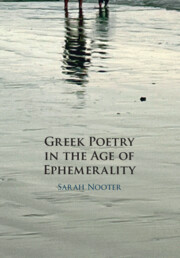Book contents
- Reviews
- Greek Poetry in the Age of Ephemerality
- Greek Poetry in the Age of Ephemerality
- Copyright page
- Dedication
- Contents
- Acknowledgments
- Notes on the Text
- Introduction: Ephemerality and Endurance in Ancient Greek Poetry
- Part I Bodies
- Part II Texts
- 4 Situating Simonides: Stones, Song, and Sound
- 5 Writing the Future: Pindar, Aeschylus, and the Tablet of the Mind
- 6 Recovering the Bodies of Archilochus’ Cologne Epode and Timotheus’ Persae
- Epilogue: The Shape of Time
- Bibliography
- Index
5 - Writing the Future: Pindar, Aeschylus, and the Tablet of the Mind
from Part II - Texts
Published online by Cambridge University Press: 02 June 2023
- Reviews
- Greek Poetry in the Age of Ephemerality
- Greek Poetry in the Age of Ephemerality
- Copyright page
- Dedication
- Contents
- Acknowledgments
- Notes on the Text
- Introduction: Ephemerality and Endurance in Ancient Greek Poetry
- Part I Bodies
- Part II Texts
- 4 Situating Simonides: Stones, Song, and Sound
- 5 Writing the Future: Pindar, Aeschylus, and the Tablet of the Mind
- 6 Recovering the Bodies of Archilochus’ Cologne Epode and Timotheus’ Persae
- Epilogue: The Shape of Time
- Bibliography
- Index
Summary
Chapter five demonstrates how the ambition to preserve the past in song and stone leads to the hope of securing a stable sense of the future in the poetry of Pindar and the tragedies of Aeschylus. Here we see how the mere image of writing becomes a vehicle in epinician and tragic poetry not only for imagining systems of memorialization and justice, but also for questioning the systems thus imagined.
- Type
- Chapter
- Information
- Greek Poetry in the Age of Ephemerality , pp. 165 - 194Publisher: Cambridge University PressPrint publication year: 2023

